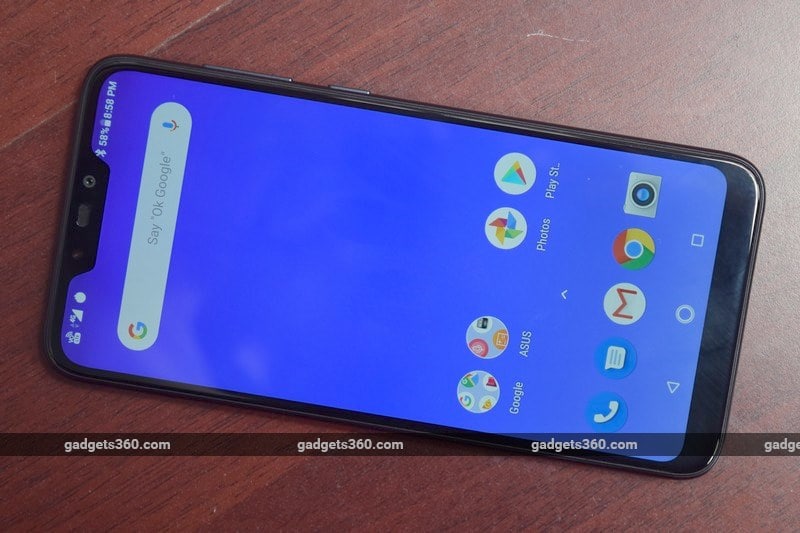- Home
- Mobiles
- Mobiles Reviews
- Asus ZenFone Max M2 Review
Asus ZenFone Max M2 Review

Asus ZenFone Max M2 price in India starts at Rs. 9,999
Asus has had an eventful year, going from a niche background player to one of the most consistent names on our lists of value-for-money smartphones. Starting with the ZenFone Max Pro M1, the company has launched no fewer than seven models in India this year, each one in a strategically chosen price band. Now, just before the curtain falls on 2018, we have the company's latest budget offering in for review. The new Asus ZenFone Max M2 comes just two months after the ZenFone Max M1 and is meant to slot in above it at a slightly higher price point rather than replace it.
Priced starting at Rs. 9,999, the new ZenFone Max M2 is a bit more expensive than the ZenFone Max M1 (Review) and overlaps the ZenFone Max Pro M1 (Review). Asus tells us that the older models aren't going away just yet, which is a bit of a surprise. All this is bound to get confusing, especially with such similar product names.
There's also fresh competition from Xiaomi, Honor, Realme, and others at or around the same prices, so buyers have no shortage of choices. We're about to sort through the clutter to show you exactly what Asus brings to the table with this refreshed model.
Asus ZenFone Max M2 design
Similar to the ZenFone Max Pro M2 (Review) which launched alongside it, the new ZenFone Max M2 is a fairly large phone with a notched screen. If you look at these two phones head-on, the only difference is that the ZenFone Max M2 has a slightly wider notch with the earpiece in the centre rather than integrated into the frame above it, as on the higher-end model.
A status LED is hidden within the earpiece, and discovering it was a pleasant surprise. At 6.26 inches diagonally with relatively narrow borders all around, this screen does have a strong visual impact that helps make this phone seem impressive.
From any other angle, there are clear differences showing that the ZenFone Max M2 is positioned well below the ZenFone Max Pro M2. The more affordable model has a standard plastic frame with a metal panel on the rear, whereas its sibling is a little more aspirational, with its slick glass-effect rear and polished frame. The advantage of course is that you don't have to keep wiping fingerprints off the back of this phone.
The ZenFone Max M2 doesn't have reinforced Corning Gorilla Glass 6 like its more expensive Pro counterpart, and there's no screen guard, either preinstalled or included in the box. This isn't ideal, but is understandable given the price.
Everything else is also pretty standard for a low-cost phone – there's a Micro-USB port on the bottom, 3.5mm audio socket on the top, power and volume buttons on the right, and SIM tray on the left. There's a wide slot on the bottom for the speaker rather than a perforated grille, and we're concerned about dust and lint getting jammed in there.
If you aren't a fan of big phones in general, you probably won't warm up to the ZenFone Max M2. It's only just about usable with one hand thanks to the non-slippery metal rear, and we struggled quite a lot when we tried to use this phone in its included plastic protective case. It's also not the easiest phone to fit into a trouser pocket.
![]()
Asus ZenFone Max M2 specifications and software
With this launch, we see the next chapter of a familiar story playing out. Asus has managed to offer a relatively powerful processor at a new low price. This time, it's the Qualcomm Snapdragon 632 which is very new – we've only seen it in one phone before now; the Honor 8C (Review). This processor is listed as having eight Kryo 250 CPU cores running at up to 1.8GHz. Four of them are high-performance Kryo 250 Gold cores while the others are power-efficient Kryo 250 Silver cores.
With a starting price of Rs. 9,999 for the variant with 3GB of RAM and 32GB of storage, Asus is undercutting Honor by a significant margin, and this is the variant we're reviewing. You can also get the ZenFone Max M2 with 4GB of RAM and 64GB of storage for Rs. 11,999. All buyers will get 100GB of Google Drive space for a year.
The 6.26-inch screen has a resolution of 720x1520 which works out to a 19:9 aspect ratio. Its corners are very rounded, which makes it feel as though some useful space has been lost. The ZenFone Max M2 has a generous 4000mAh battery, which is a surprise given the relatively low weight. Qualcomm Quick Charge isn't supported but you do get a 10W adapter in the box.
Thankfully, there are two Nano-SIM slots and a dedicated microSD slot in the SIM tray, which is always nice to see. 4G and VoLTE are supported on both SIMs. You also get Wi-Fi 802.11b/g/n, Bluetooth 4.2 and GPS. There's a gyro sensor and digital compass in addition to the basic ambient light and proximity sensors.
The 13-megapixel primary rear camera features electronic stabilisation and an f/1.8 aperture, which Asus says is the best in this price class. It's accompanied by a 2-megapixel depth sensor and a single-LED flash. The front camera has an 8-megapixel sensor and f/2.0 aperture.
Asus remains committed to stock Android for its low-end phones. We think this is a good thing in general, but some users might prefer the extra features that other brands integrate into their custom UIs, such as the ability to run two instances of messaging apps like WhatsApp.
The ZenFone Max M2 comes running Android 8.1, and the company has promised an Android 9 update in January 2019, which isn't too far off. Facebook, Messenger, and Instagram come preloaded, which we can deal with. Asus also adds its own useful calculator, voice recorder, and FM radio apps.
![]()
Asus ZenFone Max M2 performance, battery life, and cameras
When we tested the Honor 8C with the same Snapdragon 632 SoC, we reported a few hiccups in performance. That was not the case with the ZenFone Max M2, even though it has less RAM. The stock Android UI was consistently smooth throughout our review period, and light 3D games such as Giant Boulder of Death didn't give us any trouble either.
Asphalt 9: Legends ran fine at low quality settings. It was perfectly smooth, but the visuals weren't too sharp, which is perfectly fine considering the price of this phone. It got very slightly warm after playing games for about 15 minutes.
In terms of everyday usability, one curious issue was that status icons seemed to get cut off by the notch. While we appreciate being able to see the battery percentage all the time, it pushes the vibration indicator too far off the edge. Asus might need to tweak its software to properly recognise the notch's width.
Full-screen games and video apps also mask the notch by default and there's no way for apps to expand into the space at its sides. A lot of people might actually like this, and we didn't mind at all. Of course, this might change with future software updates.
The display is bright enough, but colours don't really pop all that much. We'd prefer a full-HD resolution on a screen this size, but we aren't complaining because of the price. We were also very impressed with the speaker, which is not only loud but also produces quite rich, deep sound.
Many of our standard benchmark tests were unable to run, most likely due to Asus locking down its software prior to this phone's official launch. AnTuTu and 3DMark could not be installed. Geekbench did run, and gave us single-core and multi-core scores of 1,200 and 4,467 respectively. GFXBench also posted an impressive 35fps in the T-Rex scene and 14fps for the Manhattan 3.1 scene.
![]()
Battery life was superb, and this was one area in which the ZenFone Max M1 really shines. Our day of testing involved quite a bit of video streaming, and experimenting with apps and games. We got through a full day starting at around 9am, and had nearly 30 percent left by late evening.
Our HD video loop test ran for a solid 13 hours, 34 minutes which is more than what the ZenFone Max M1 managed, but less than competing phones such as the Realme 2 (Review), Honor 8C (Review), and Redmi 6 Pro (Review).
While our experiences using the ZenFone Max M2 have so far have been impressive, we're reminded that it is after all a low-cost phone when it comes to reviewing its cameras. Taking photos was the only thing that felt laggy because it often took a while for this phone to lock focus and save shots. It even displayed a 'Processing' message on screen sometimes. while we were waiting.
Daytime shots were surprisingly well detailed, but colours were a bit muted. You have to get close to your subject for the best results but even landscapes will look decent enough if you don't zoom in all the way. Shots taken using the Depth Effect mode didn't look natural at all – object edges weren't well defined at all, and the background blurring was harsh.
At night, we really struggled to get usable shots. Despite the much-touted f/1.8 aperture, this camera did not pick up a lot of detail, and many of our shots came out blurry or just murky. There were times when photos seemed fine on screen right as we were taking them, because the viewfinder freezes on stills as they were framed.
![]()
![]()
![]()
![]() Tap to see full-sized Asus ZenFone Max M2 photo samples
Tap to see full-sized Asus ZenFone Max M2 photo samples
However, tapping over to the gallery showed that those very same shots were actually quite blurry because we had moved too soon, thinking they had been saved. It took a while to realise this, and adjust our behaviour accordingly.
Video recording goes up to 4K with the rear camera, but we'd suggest that users disregard this setting. 1080p footage wasn't bad at all though, and there was minimal focus hunting with moving objects. At night, video was as poor as stills, and our shots came out looking very poor.
The front camera is fairly decent, and users should be happy with the quality of selfies they can take for social media. Asus does say that planned future updates will bring EIS and the Depth Effect mode to the front camera, which is good to know.
We also have to mention that Asus is still struggling with the UI of its camera app. We first pointed out issues with the ZenFone Max Pro M1, and many still persist. For example, it takes three taps to begin recording a video, and the UI isn't very well organised.
![]()
Asus ZenFone Max M2 in pictures
Verdict
The Asus ZenFone Max M2 seems like a competent entry-level device. It has enough power to make sure that budget buyers don't have to struggle with a compromised usage experience. You can enjoy games and videos on the big screen, and you won't feel constrained when running most everyday apps.
Battery life is definitely good, but this phone stumbles where many budget models do – with its cameras. It also might be a bit too physically large for some buyers' liking.
The ZenFone Max M2 is a big step up from the ZenFone Max M1, and fills a small but strategically significant price gap between that model and the Pro equivalents of both models. Anyone who recently bought the ZenFone Max M1 based on its price need not feel too disappointed, since this isn't a direct replacement.
This phone trades blows with the Honor 8C (Review), Realme 2 (Review), and Redmi 6 Pro (Review). It compares favourably in terms of design, processing power and software, but loses out slightly in terms of battery life. It certainly doesn't stand out for its camera quality, but it's good enough for the general standard of this category.
All in all, most of these factors even out, and your choice should be based on what parameters you prioritise. The best thing that can be said is that it pushes prices down, and there's no sign of the price war abating.
Is Asus ZenFone Max M2 the best phone under Rs. 10,000? We discussed this on Orbital, our weekly technology podcast, which you can subscribe to via Apple Podcasts or RSS, download the episode, or just hit the play button below.
Get your daily dose of tech news, reviews, and insights, in under 80 characters on Gadgets 360 Turbo. Connect with fellow tech lovers on our Forum. Follow us on X, Facebook, WhatsApp, Threads and Google News for instant updates. Catch all the action on our YouTube channel.
Related Stories
- Samsung Galaxy Unpacked 2025
- ChatGPT
- Redmi Note 14 Pro+
- iPhone 16
- Apple Vision Pro
- Oneplus 12
- OnePlus Nord CE 3 Lite 5G
- iPhone 13
- Xiaomi 14 Pro
- Oppo Find N3
- Tecno Spark Go (2023)
- Realme V30
- Best Phones Under 25000
- Samsung Galaxy S24 Series
- Cryptocurrency
- iQoo 12
- Samsung Galaxy S24 Ultra
- Giottus
- Samsung Galaxy Z Flip 5
- Apple 'Scary Fast'
- Housefull 5
- GoPro Hero 12 Black Review
- Invincible Season 2
- JioGlass
- HD Ready TV
- Laptop Under 50000
- Smartwatch Under 10000
- Latest Mobile Phones
- Compare Phones
- Realme P4x 5G
- OnePlus Ace 6T
- OPPO A6x 5G
- Samsung Galaxy Z TriFold
- Poco F8 Ultra
- Poco F8 Pro
- Huawei Mate 80 RS Master Edition
- Huawei Mate 80 Pro Max
- Asus ProArt P16
- MacBook Pro 14-inch (M5, 2025)
- Poco Pad M1
- Poco Pad X1
- Just Corseca Skywatch Pro
- Honor Watch X5
- Acerpure Nitro Z Series 100-inch QLED TV
- Samsung 43 Inch LED Ultra HD (4K) Smart TV (UA43UE81AFULXL)
- Asus ROG Ally
- Nintendo Switch Lite
- Haier 1.6 Ton 5 Star Inverter Split AC (HSU19G-MZAID5BN-INV)
- Haier 1.6 Ton 5 Star Inverter Split AC (HSU19G-MZAIM5BN-INV)


















